Exhibit Update:
Placing Dinosaurs in Their World
The world’s premier home
for dinosaurs requires space and time.
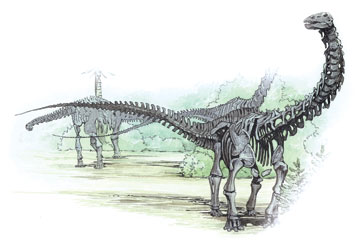 R.J. Gangewere R.J. Gangewere
Carnegie Museum of Natural History Director Bill DeWalt
says that creating the proper space for the new Dinosaurs
in Their World exhibit “is taking a great deal
of time and thought to ensure that we have the proper
phasing and best locations for all that we have to
move.”
The museum has re-examined the best uses
of space for the public areas, the collections, and
research areas,
and the “back of the house” operations.
The goal is to create more public space within the
historic building, better protect the collections,
and, where possible, move business operations out
of the building.
To make room for Dinosaurs in Their
World, it is
imperative to move the Natural History Library
to a location where
it will serve as “the physical and philosophical
core of the research and collections areas,” says
DeWalt. The most likely location for the library
is in the rear of the first floor.
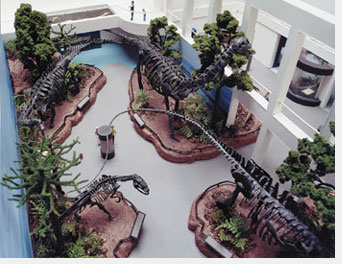 An
artistic vision of the future Dinosaurs in Their World
exhibit is captured in models and illustrations at
the entrance to the current hall. An
artistic vision of the future Dinosaurs in Their World
exhibit is captured in models and illustrations at
the entrance to the current hall.
The museum will
also use this period of change to upgrade its
scientific collections and research
areas.
The
Invertebrate Zoology (bugs) and Botany collections
will be air-conditioned and collections will
receive better protection. The museum is also applying
for a separate grant to provide climate control
for the
fossils stored in the basement to protect these
invaluable specimens as the national treasures
that they are. Looking ahead, DeWalt says that
in the spring of 2004 the architect for the new hall
will be
selected,
and
significant construction will begin in early
2005. Time will be needed not only for construction
and for moving departments,
but also
for dismantling the famous dinosaur specimens,
and then reconstructing them according to modern
scientific
standards. By some time in 2007—on the
100th anniversary of expansion of the museum
into the present
building—the newly constructed atrium
for the dinosaurs is expected to open. The
renovated existing
Dinosaur Hall will probably not open until
late 2008 or early 2009.
“
It is truly gratifying to me to know that leaders in
our community see this expansion just as we do—as
the creation of a first-day attraction for Pittsburgh,” says
DeWalt. “These leaders understand that the Museum
of Natural History is a world treasure. They want to
invest in a great exhibit that reflects the world-class
standards of our science.”
Dinosaurs in Their World Funding Tops $25 Million
October 2003 was a big month for the Dinosaurs
in Their World project, starting with the announcement by
Eden Hall Foundation that it would give a lead gift
of $5 million in support of the creation of the world’s
premier dinosaur exhibits.
The Heinz Endowment soon
followed with an announcement of its gift of $4
million, which is the first but not
the last it plans to give to the Carnegie Museums
Campaign. “The
educational, economic development, and cultural benefits
of this project are incredibly far-reaching,” says
Maxwell King, president of The Heinz Endowments,
of the Dinosaur Hall project. “Pittsburgh has
the opportunity to create something that is truly
one-of-a-kind,
and that's exciting.”
Another $500,000 gift
from the Walton/Whetzel Family, and an anonymous
gift of $250,000 have brought Carnegie
Museum of Natural History ever closer to its fundraising
goal of $35 million for creating Dinosaurs
in Their World.

February
7 – August 15, 2004
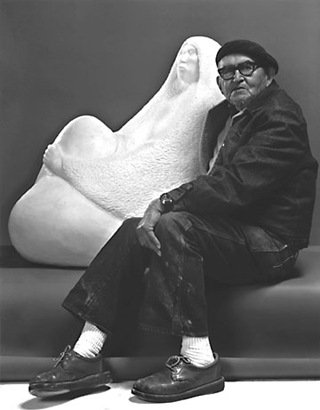 Allan Houser (1914-1994) has been credited with
reviving the art of stone sculpture in the United
States. In 1992 he was awarded the National Medal
of Arts by President George Bush, becoming the
first Native American to receive the nation’s
highest honor for artists and joining the ranks
of luminaries such as Georgia O'Keeffe, Marian
Anderson, Ella Fitzgerald, and Aaron Copeland. Allan Houser (1914-1994) has been credited with
reviving the art of stone sculpture in the United
States. In 1992 he was awarded the National Medal
of Arts by President George Bush, becoming the
first Native American to receive the nation’s
highest honor for artists and joining the ranks
of luminaries such as Georgia O'Keeffe, Marian
Anderson, Ella Fitzgerald, and Aaron Copeland.
Monumental,
intimate, and steeped in history, his sculptures
have been internationally acclaimed
and are included in collections of the Smithsonian
Institution, the Centre Georges Pompidou in Paris,
the Metropolitan Museum of Art, the White House,
and the British Royal Collection. In 1985 his
monumental bronze Offering of the Sacred Pipe was
dedicated
at the United Nations building in New York City.
Houser’s
first commission for a sculpture in 1949 came
from the Haskell Institute in Lawrence, Kansas—a
memorial in stone of Indian servicemen killed
in World War II. He later received a Guggenheim
grant in sculpture and
painting. "When I won my Guggenheim fellowship, I said I wanted to become
one of the best—whether painter or sculptor—in the world. That's
what my efforts are going to be, whether I get there or not," Houser
said.
A Chiricahua Apache, Houser was born on his parents'
government-grant farm in Apache, Oklahoma in 1914,
as the tribe was emerging from 27 years
in forced
exile
from their native mountains in the Southwest. His father, Sam Haozous,
was captured with Geronimo in 1886, and later served
as the great chief's interpreter.
Allan
grew up listening to his father play the drum, sing medicine songs, and
tell the stories of Geronimo.
The Sculptures of
Allan Houser features bronze and stone
sculptures, and original drawings and sketches.
A feature
of the exhibit is the thematic
development
of Houser’s bronze portrayals of the Chiricahua Apache Mountain
Spirit Dancer. Dominating the installation is a spectacular monumental
version
of Spirit of
the Wind (1992) with its soaring abstract atmospheric forms. The exhibit
is made possible by an anonymous donor and the Houser Foundation.
Tim Pearce, Mollusk Specialist
Finding clues to the environment
in snails, mussels and slugs
Tim Pearce, assistant curator of mollusks
at Carnegie Museum of Natural History, is one of the leading specialists
in the world on mollusks,
and Carnegie Museum of Natural History has one of the most important
mollusk collections in the United States.
Mollusks such
as clams and snails, as well as soft-bodied animals like slugs,
are key
animals in the world-wide food chain, as well
as critical indicators of environmental
conditions. They are among the first to give warning signs of water
pollution and degradation,
and of the reverse—the renewed health in streams, wetlands,
marshes, ponds, and lakes. Their return to the rivers around Pittsburgh
is a success story. Historically, the freshwater mussels of the
Upper Ohio watershed were used commercially for button making,
as well
as collected for their beauty.
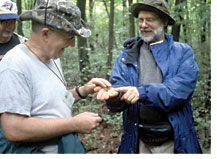 Tim
Pearce (right) shows a land snail to a visitor at the Bioforay at
Powdermill Nature Reserve. Tim
Pearce (right) shows a land snail to a visitor at the Bioforay at
Powdermill Nature Reserve.
PHOTO:MINDY MCNAUGHER
Pearce’s
own research on the distribution of land snails has ranged from
the Kuril Islands
of Eastern Russia and Madagascar to
the State of Washington, and the Michigan islands. Regionally,
he is an expert on mollusks found in the Delmarva Peninsula
(the peninsula
on Chesapeake Bay) defined by parts of the states of Delaware,
Maryland and Virginia. The
museum’s mollusk collection goes
back to the 19th century and contains more than three million
specimens, including 1,100 type
specimens that first identified the species.
When in 2003
one of the museum’s educators brought a snail
to Pearce for identification, Pearce immediately recognized
it as a giant African snail, Achatina fulica, a federally listed
pest species.
This snail had grown to 4.5 inches in a year after the educator
found it in a park in Upper St. Clair. A voracious eater, Achatina
fulica reproduces easily, and has a history of damaging crops
once it is established. In November, Pearce and experts from the
federal
government
and the Pennsylvania Department of Agriculture searched
the park and found no more Giant African snails. But they will
return
in the
warmer weather to check again. Someone apparently had kept
this snail as a pet and then released it in the park. Pearce advises
that people “keep
their pets, even if they do not have big eyes and hair,” until
they die.
“
Land snails get around,” he adds. “They raft on material
in streams, ride on the feet or feathers of birds, or on leaves blown
by the wind.” One of his goals is to make the museum’s
collection of snails available to scientists on the internet. Another
goal is to identify fully all the species of slugs that live in Pennsylvania—another
creature that scientists view as a sensitive barometer
to the environment.
Cynthia Morton, Botanist
Molecular biology for oranges, limes,
and beans
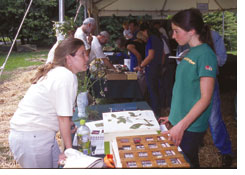 Cynthia
Morton (left) discusses native plants at Powdermill
Nature Reserve. Cynthia
Morton (left) discusses native plants at Powdermill
Nature Reserve.
PHOTO:MINDY MCNAUGHER
The associate curator and head of the section of botany,
Cynthia Morton, is an expert on the molecular and
genetic makeup of citrus plants such as lemon, grapefruits,
oranges, and mandarins. Her research has strong agricultural
and economic implications as she seeks to further
define
the genetic basis of these plants. The orange-growing
industries of Florida, California, and Australia,
for example, seek cold tolerant and disease resistant
plants,
and her research is the kind that can discover where
to look for disease resistant genes or cold tolerant
rootstocks. But Morton also believes that, given
the 160 or so different forms of citrus plants, oranges
could grow in more northern regions if the right
combination
of rootstocks and genetic makeup were combined. Another
of her projects involves work with a colleague from
Benin in Africa. They have just published the
first genetic map for the rotational crop velvet
bean. They hope to develop a new form of the velvet
bean
(Mucuna) as a rotational crop for Africa, South America,
and the southern United States—a plant that
is very important because of its nitrogen-fixing
capabilities
and its potential use as a food source. She notes
that molecular biology of the kind she practices
is not
done easily in most third-World countries.
Another
of her interests is bio-remediation of the environment—cleaning
up contaminated sites with naturally occurring
bacteria as opposed to more expensive
and labor-intensive techniques.
As a skilled molecular
systematist with a Ph.D. in Biology, Morton could
work in industry or at
a university,
but she feels that the museum gives her flexibility
to focus on conservation, and on genetically
diverse plant species of value to everyone. The museum’s
Molecular Laboratory is very important to her: “We’ve
come so far in technology that I can now do molecular
research without radioactivity, and I can do in
two and a half hours what would have taken me a
week and
a half to do not so many years ago.” But
she also says as she heats a brew of beef juice
and plant
chemicals in beaker dishes, “A lot of this
physical research is not that difficult—it
can be done manually. People are often wrongly
intimidated by technology.”
Back to Contents |